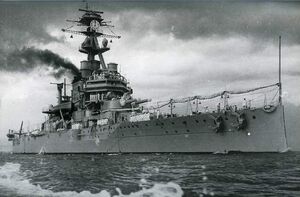The Battleship São Paulo was a battleship of the Brazilian Navy, from the Minas Gerais class. It was the second ship of the fleet to receive this name in honor of the Brazilian state of São Paulo.
History[]
Background[]

E São Paulo
At the beginning of the twentieth century the Navy of Brazil began a program of technological modernization and acquisition of ships, aiming recomplementar and refit the fleet. It found itself obsolete since the end of the Empire (1889), among other factors:
- the rapid evolution of media due to the arms race among the industrialized nations including the last quarter of the nineteenth century and first decade of the twentieth century;
- the lack of acquisition of new media by the Brazilian republican government, recently implemented, and
- according to the damage caused by the two rebellions of the Navy.
In accordance with the guidelines of foreign minister, Jose Maria da Silva Paranhos (Baron of Rio Branco), and the navy minister, Julio Cesar de Noronha in 1904, the government of President Rodrigues Alves commissioned in 1906 in Britain, three large ships battleships "Class Dreadnought," which, in Brazil, was named "Class Minas Geraes". However, by diplomatic pressure from Argentina, fearful of naval power in Brazil, and difficulties of financing the purchase of vessels, the initial order of three battleships was reduced to only two of 23,500 tons maximum displacement, baptized with the names "Minas Gerais"and" São Paulo".
Built in the shipyard Vickers, Sons & Maxim at Barrow-in-Furness, after the keel was laid (April 30 of 1907), was launched at sea (April 19 of 1909) and incorporated in June 12 of 1910. It was its first commander, Captain of Sea and War Francisco Gavião Pereira Pinto, soon replaced by Captain of Sea and War Francisco Marques Pereira de Souza.
Operations and activities[]
On its maiden voyage to Brazil, led the President-elect Marshal Hermes da Fonseca, from Cherbourg to Rio de Janeiro, and assisted in the scale in Lisbon, the Portuguese Republic Day (October 5 of 1910).
In early November 1910, the two new battleships and cruiser Bahia (C-12), participated in the so-called Revolt of the Whip.
Both the "Minas Gerais" and the "São Paulo" participated in the bombing of Salvador (1912), in the context of

E São Paulo defending the port of Recife in 1942
so-called policy of bailouts.
Later, during the First World War (1914-1918), worked hard at work patrolling the Brazilian waters.
Modernization was seized between 1918 and 1920, when she received improvements to its weapons systems and propulsion, with the replacement of its old boilers to coal for the engine oil.
In the context of the Revolt of 18 at the Copacabana Fort, on July 6 of 1922, accompanied by the "Minas Geraes" and a destroyer, opened fire on the Fort of Copacabana.
During the Second World War in 1942, was part of the defense system of the port of Recife, in Pernambuco.
Was in active service until 1951, when it was descomissioned. Sank in the Atlantic Ocean en route to be scrapped at the same year.
Specifications[]
- Class: Minas Gerais and São Paulo
- Normal Displacement: 19,280 tons
- Displacement full load: 21,200 tons
- Length: 161.5 m
- Beam: 25.3 m
- Draft: 8.5 m
- Main Armament: 12 guns, 12-inch 50-gauge in six towers of two parts
- Secondary Armament: 22 guns of 120 mm 50 caliber guns and eight 47 mm
- Shielding the belt: 228.6 mm to 102.4 mm
- Armour deck: 57 mm
- Shielding the towers: 305 mm to 204 mm
- Shielding on the bridge: 305 mm
- Engines: 2 shaft, triple expansion, Babcock boilers, 23,500 hp.
- Speed: 21 knots
- Coal Capacity: 800 to 2350 tons
- Range: 10,000 miles at 10 knots
- Crew: 900
- Cost: £616,360
See also[]
- Minas Gerais Class Battleship (1908)
- E Minas Gerais (1909)
- List of decommissioned ships of the Brazilian Navy
The original article can be found at E São Paulo (1909) and the edit history here.